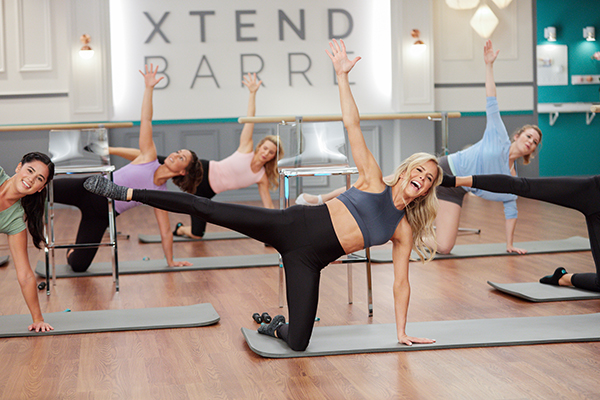
If strong, sculpted arms are one of your fitness goals, you might assume the only way to get them is to perform endless biceps curls and triceps kickbacks. But if you’ve done an at-home barre workout, like Xtend Barre or Barre Blend, you’ve likely felt the burn in your arms.
So can you get a solid strength training workout from those barre arm exercises? Here’s what you need to know.
Does Barre Build Strength in the Arms?
“Absolutely!” says Jen Cordiner, education director for Xtend Barre, an at-home barre program that incorporates cardio, Pilates, and ballet fundamentals to help you burn fat and build muscle.
Barre workouts typically combine bodyweight exercises with high reps to strengthen and build your muscles.
“A focus on proper form and creating your own resistance help lead to a long, lean, sculpted upper body,” Cordiner says. Your target muscles may burn and shake — surefire signs that the routine is working.
Many Xtend Barre workouts also incorporate equipment such as resistance bands or light hand weights to boost the intensity of barre arm exercises. This can really ramp up your upper-body toning results, Cordiner says.
Is Barre Considered a Strength or Cardio Workout?

Traditional barre workouts use small, isometric exercises to help you build total-body strength and definition — minimal cardio included.
However, BODi’s barre programs are unique in that it blends traditional isometric exercises with dynamic movements that get you moving through a full range of motion.
The result: You get strength and cardio benefits in a single session. “Our combination of sculpt and cardio offers a full-body workout, which leads to better results,” Cordiner says.
How Often Should I Do Barre Arm Exercises to Increase Strength?
If you really want to see and feel strength results, Cordiner recommends doing barre three to five days a week. As your strength and endurance grow, you can bump up your weekly sessions to five or more.
Ready to get started? Try an Xtend Barre or Barre Blend workout on BODi. Choose from total-body routines, or give specific muscle groups (ahem, your arms) extra attention with focused workouts.
Don’t have a ballet barre? No worries — a sturdy chair, countertop, or the back of the couch will do the trick, so you can start enjoying the benefits of barre arm exercises.
The post Do Barre Arm Exercises Count as Strength Training? appeared first on BODi.
body {
font-family: Arial, sans-serif;
margin: 20px;
}
h1 {
text-align: center;
font-size: 30px;
}
h2 {
font-size: 24px;
margin-top: 30px;
}
p {
font-size: 16px;
line-height: 1.5;
}
ul {
list-style-type: disc;
margin-left: 20px;
}
Are Barre Arm Exercises Legit Strength Training or Just Another Trend?
The Rise of Barre Workouts
Barre workouts have gained significant popularity in recent years, attracting individuals looking to improve their overall fitness and tone their bodies. Originating from a blend of ballet, Pilates, and yoga, barre exercises primarily focus on strengthening the core, legs, and arms. While the effectiveness of barre workouts for the lower body is widely acknowledged, there is often skepticism surrounding the effectiveness of barre arm exercises. So, are barre arm exercises legit strength training or just another fitness trend?
The Science Behind Barre Arm Exercises
Barre arm exercises involve performing a series of small, repetitive movements using light weights or resistance bands. These exercises typically target the biceps, triceps, shoulders, and upper back muscles. While the movements may seem simple and low-intensity, they are designed to fatigue the muscles through isometric contractions and continuous tension.
Building Strength and Endurance
While barre arm exercises may not result in bulging biceps like traditional weightlifting, they can offer numerous benefits in terms of strength and endurance. The repetitive nature of the exercises helps to build muscular endurance, allowing you to perform daily activities with less fatigue. Additionally, the isometric contractions involved in barre workouts help to strengthen and tone the muscles without adding bulk.
Improving Posture and Stability
Barre arm exercises also contribute to improved posture and stability. By engaging the muscles in your upper body, particularly the back and shoulders, these exercises can help correct muscular imbalances and promote better alignment. Strengthening the muscles around your shoulder joints can enhance stability and reduce the risk of injuries.
Enhancing Flexibility
Flexibility is another area where barre arm exercises excel. The controlled movements and stretches involved in barre workouts can help increase your range of motion and improve overall flexibility. This can be especially beneficial for individuals who spend long hours sitting or have tight muscles due to a sedentary lifestyle.
Complementing Other Strength Training
While barre arm exercises alone may not provide the same level of strength gains as traditional weightlifting, they can be a valuable addition to your overall fitness routine. Incorporating barre workouts into your training regimen can help diversify your exercise routine, prevent plateaus, and target muscles in unique ways. By combining different forms of strength training, you can achieve a well-rounded and balanced physique.
Conclusion
Barre arm exercises are indeed legit strength training exercises that offer numerous benefits for individuals seeking to improve their overall fitness. While they may not replace traditional weightlifting for those aiming to build significant muscle mass, barre arm exercises provide an effective way to enhance muscular endurance, improve posture and stability, increase flexibility, and complement other strength training methods.








